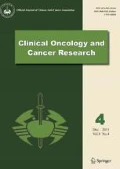Abstract
Objective
To investigate the clinicopathologic features of atypical endometriosis (AEM), and to discuss the relations between AEMs and tumors.
Methods
A retrospective analysis was performed on 163 cases of AEMs. The changes in the glandular epithelium, stroma, and their background and the relationship with coexisting tumors were observed.
Results
The AEMs account of for 4.4% (163/3,724) of the endometriosis (EM) cases. Of 172 AEM foci of 163 patients, 168 were in the ovary, and the other 4 were in the fallopian tube, cervix and uterine serosa. Of the cases of ovarian EM, 6.8% were AEM. All of the 27 cases (15.7%) of the AEMs associated with a tumor were found in the ovaries, of which 15 were malignant, 9 borderline, and 3 benign. Of the ovary AEMs, 14.9% were associated with a borderline or malignant tumor. The AEM epithelia were mainly arranged in the form of surface epithelia, with only a few glands. Present were characteristic features of moderate to marked pleomorphism, epithelial tufting, bud or firework-like structures on microscopy. Epithelial metaplastic changes were observed in 86 cases (50%) of the 172 AEM foci. Epithelium, endometrioid stroma, and fibrotic-collagen formed a three-layer structure in the wall of the AEM cysts. The endometrioid stroma were usually thin compared to the fibro-collagen tissue. The transformation from an AEM to a tumor was found in most of the malignant tumors.
Conclusion
AEM lesions have some features which are similar and also differ from both of the tumor and EM. AEMs have a relative higher potential for tumorigenesis and canceration, especially for ovarian cancer. The process of damage, repair, and scarring in EM foci over a long period may play a role in the development of EM into AEM and eventally into tumor formation.
Similar content being viewed by others
References
Fukunaga M, Nomura K, Ishikawa E, et al. Ovarian atypical endometriosis: its close association with malignant epithelial tumors. Histopathology 1997; 30: 249–255.
Nishida M, Watanabe K, Sato N, et al. Malignant transformation of ovarian endometriosis. Gynecol Obstet Invest 2000; 50: 18–25.
LaGrenade A, Silverberg SG. Ovarian tumors associated with atypical endometriosis. Hum Pathol 1988; 19: 1080–1084.
Van Gorp T, Amant F, Neven P, et al. Endometriosis and the development of malignant tumours of the pelvis. A review of literature. Best Pract Res Clin Obstet Gynaecol 2004; 18: 349–371.
Czernobilsky B, Morris WJ. A histologic study of ovarian endometriosis with emphasis on hyperplastic and atypical changes. Obstet Gynecol 1979; 53: 318–323.
Sainz de la Cuesta R, Izquierdo M, Canamero M, et al. Increased prevalence of p53 overexpression from typical endometriosis to atypical endometriosis and ovarian cancer associated with endometriosis. Eur J Obstet Gynecol Reprod Biol 2004; 113: 87–93.
Yantiss RK, Clement PB, Young RH. Neoplastic and pre-neoplastic changes in gastrointestinal endometriosis: a study of 17 cases. Am J Surg Pathol 2000; 24: 513–524.
Akahane T, Sekizawa A, Okuda T, et al. Disappearance of steroid hormone dependency during malignant transformation of ovarian clear cell cancer. Int J Gynecol Pathol 2005; 24: 369–376.
Steed H, Chapman W, Laframboise S. Endometriosis-associated ovarian cancer: a clinicopathologic review. Obstet Gynaecol Can 2004; 26: 709–715.
Sekizawa A, Amemiya S, Otsuka J, et al. Malignant transformation of endometriosis: application of laser microdissection for analysis of genetic alterations according to pathological changes. Med Electron Microsc 2004; 37: 97–100.
Oral E, Ilvan S, Tustas E, et al. Prevalence of endometriosis in malignant epithelial ovary tumours. Eur J Obstet Gynecol Reprod Biol 2003; 109: 97–101.
Ali-Fehmi R, Khalifeh I, Bandyopadhyay S, et al. Patterns of loss of heterozygosity at 10q23.3 and microsatellite instability in endometriosis, atypical endometriosis, and ovarian carcinoma arising in association with endometriosis. Int J Gynecol Pathol 2006; 25: 223–229.
Seidman JD. Prognostic importance of hyperplasia and atypia in endometriosis. Int J Gynecol Pathol 1996; 15: 1–9.
Ogawa S, Kaku T, Amada S, et al. Ovarian endometriosis associated with ovarian carcinoma: a clinicopathological and immunohistochemical study. Gynecol Oncol 2000; 77: 298–304.
Sainz de la Cuesta R, Eichhorn JH, Rice LW, et al. Histologic transformation of benign endometriosis to early epithelial ovarian cancer. Gynecol Oncol 1996; 60: 238–244.
Fukunaga M, Ushigome S. Epithelial metaplastic changes in ovarian endometriosis. Mod Pathol 1998; 11: 784–788.
Mazur MT, Kurman RJ. Diagnosis of Endometrial Biopsies and Curettings, A Practical Approach, 2nd. USA, Springer. 2002: 195–198.
Author information
Authors and Affiliations
Corresponding author
About this article
Cite this article
Guo, D., Pang, S. & Shen, Y. Atypical endometriosis: a clinicopathologic study of 163 cases. Chin. J. Clin. Oncol. 4, 405–410 (2007). https://doi.org/10.1007/s11805-007-0405-0
Received:
Accepted:
Issue Date:
DOI: https://doi.org/10.1007/s11805-007-0405-0




